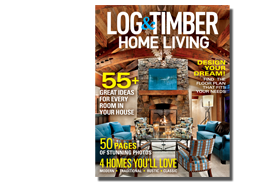Basic Biology
Like mushrooms, mold is a fungus that originates from spores. It’s a living organism, often characterized by a slimy appearance. Mildew is a particular type of mold that tends to be fuzzier and lighter in color.All molds are critical to a healthy, natural environment, playing a key role in breaking down organic material, like wood, and turning it back into soil. Of course, no homeowner wants their home’s logs to be a part of this process though, which is why it’s important to address mold and mold discolorations early.
To grow and thrive, mold spores need moisture, a food source and oxygen. Remove any one of these components and you won’t have mold. Mold spores can also remain dormant for a long time, waiting for the just-right conditions to begin growing.

Removing Mold & Discoloration
Removing mold is a simple process, especially if it’s on a hard surface. You simply apply your cleaner and wipe. If it’s on a porous surface however, like wood, the mold can attach deeper into the material’s fibers.What to do? Mold does not like acidic cleaners because these alter the pH level, therefore creating an inhospitable environment for growth. That said, acids aren't always a complete solution, especially on porous materials like wood where mold can grow below the surface. In those cases, a cleaner specifically formulated for mold and mildew removal (often with antifungal ingredients) is a better long-term solution. Log Wash or Wood ReNew are two recommended Perma-Chink products that will remove dirt, dust, mold and pollen, as well as many types of bare wood discolorations including brown chemical stains.

If an entire wall is black with mold — a scenario that might occur in an abandoned house — a certified professional will need to come and assess the situation. However, take heart — this level of mold damage is extremely rare in log homes.
Preventing Mold
The best way to handle mold discoloration is to prevent it from happening in the first place. Mold spores usually aren’t embedded in wood unless they get carried by water into a check or opening. Proper sealant and caulking products are critical to preventing a water intrusion. Perma-Chink has a wide array of sealants engineered for specific purposes such as their flagship elastic chinking product for wide gaps, Energy Seal for narrow gaps and Check Mate 2 made specifically for checks.For exterior log walls, washing the logs with Log Wash removes any spores and mold. Don’t be tempted to skip the Log Wash portion of the Perma-Chink system or you risk trapping spores under the top coat finish. Wood holds moisture, and while Perma-Chink’s family of Lifeline stains and Lifeline Advance Clear Top Coat allow moisture to escape, it can still be enough for mold to begin growing if spores are trapped below the top coat.
After staining with any of Perma-Chink’s Lifeline stains, applying Lifeline Advance Clear Top Coat protects the stain, beautifies the color, and prevents mold spores from entering the wood through micro-fissures or cracks. Mildew-X adds another layer of insurance against mold and algae growth. In the event mold does grow, it will be on top of the finish and easy to clean.
For interiors, Perma-Chink Systems has Lifeline Interior, a stain formulated for interior log walls, and Sure Shine, an interior top coat finish that comes in either matte or glossy. These interior products provide excellent mold protection for bathrooms, kitchens, mudrooms or anywhere prone to moisture.
Don’t let the idea of mold intimidate you. A gorgeous, high-performance, low-maintenance log home is easily protected and maintained with the right knowledge and products on your side.
Follow along! Join Perma-Chink Systems, Inc. in this exclusive Ask the Expert series to get answers to all your top questions about staining, sealing, maintenance and more!
Sponsored by Perma-Chink Systems, Inc.











